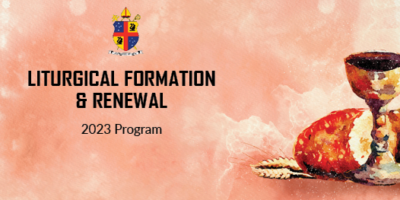Liturgical Formation and Renewal Program 2023

Pope Francis in his Apostolic Letter Desiderio Desideravi of June 2022 highlighted the need for liturgical formation.
A program of liturgical formation and renewal has been prepared for the Archdiocese. At the heart of this program of renewal, there should be a rediscovery of the richness of our Catholic faith in the Eucharist, including our belief in the real presence of Jesus Christ under the sacramental signs of bread and wine.
Train the Trainer Workshops
The aim of the phase two is to train two people from your parish or organisation to present two different formation sessions for your community.
Click on the appropriate button below to register for the workshop.
Resources - Liturgical Formation and Renewal
Resources for conducting formation sessions for the Liturgical Formation and Renewal program.
Videos - Liturgical Formation and Renewal
Four short videos have been produced to be used as part of the Liturgical Formation and Renewal program.
Parish Launch Resources - Liturgical Formation and Renewal Program
The Feast of Corpus Christi, Sunday 11 June is the official launch date for the Liturgical Formation and Renewal in the Archdiocese of Perth.
Resources have been prepared for the launch Sunday.
There are also additional resources which can be used in parishes to support this year which is dedicated to Liturgical Formation and Renewal in the Archdiocese of Perth.
